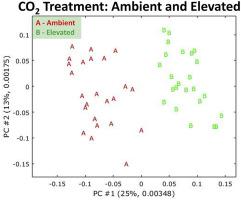当前位置:
X-MOL 学术
›
J. Cereal Sci.
›
论文详情
Our official English website, www.x-mol.net, welcomes your
feedback! (Note: you will need to create a separate account there.)
A systematic approach to determine the impact of elevated CO2 levels on the chemical composition of wheat (Triticum aestivum)
Journal of Cereal Science ( IF 3.9 ) Pub Date : 2020-09-01 , DOI: 10.1016/j.jcs.2020.103020 Ping Geng , Jianghao Sun , Pei Chen , Yanfang Li , Bing Peng , James M. Harnly , James Bunce
Journal of Cereal Science ( IF 3.9 ) Pub Date : 2020-09-01 , DOI: 10.1016/j.jcs.2020.103020 Ping Geng , Jianghao Sun , Pei Chen , Yanfang Li , Bing Peng , James M. Harnly , James Bunce

|
Abstract Two wheat genetic lines (responsive and non-responsive to elevated CO2) grown under ambient and free-air CO2 enrichment (FACE) conditions were compared using fuzzy chromatography mass spectrometry (FCMS) metabolite fingerprinting. A more comprehensive survey of the changes in their chemical composition was made on selected samples using ultra-high-performance liquid chromatography (UHPLC) metabolomic profiling with high resolution accurate mass/tandem mass spectrometry (HRAM/MSn). Principal component analysis (PCA) of the metabolite fingerprints showed four clusters for the two genetic lines (responsive and non-responsive) and the two CO2 levels (ambient and elevated) in score plots. Metabolite profiling of representative samples for each of the four clusters identified 25 and 16 compounds from negative and positive data, respectively, including amino acids, saccharides, phenolic acids, flavonoids, and lipids. Loading plots demonstrated that some saccharides and lipids were responsible for discriminating between not only two genetic lines but also two CO2 levels. Analysis of free amino acids (not bound) showed a clear pattern of reduced concentration for both lines with elevated CO2. After acid hydrolysis, the responsive line 6 (41% increase in yield) showed the same pattern observed for free amino acids, but the non-responsive line 5 (6% increase in yield) showed different trends in concentrations of amino acids with elevated CO2.
中文翻译:

确定升高的 CO2 水平对小麦(Triticum aestivum)化学成分影响的系统方法
摘要 使用模糊色谱质谱 (FCMS) 代谢物指纹图谱比较了在环境和自由空气 CO2 富集 (FACE) 条件下生长的两个小麦遗传品系(对升高的 CO2 有反应和无反应)。使用超高效液相色谱 (UHPLC) 代谢组学分析和高分辨率精确质量/串联质谱 (HRAM/MSn),对选定样品的化学成分变化进行了更全面的调查。代谢物指纹的主成分分析 (PCA) 在评分图中显示了两个遗传系(响应和非响应)和两个 CO2 水平(环境和升高)的四个簇。四个集群中每一个的代表性样品的代谢物分析分别从阴性和阳性数据中鉴定出 25 和 16 种化合物,包括氨基酸、糖类、酚酸、类黄酮和脂质。加载图表明,一些糖类和脂质不仅负责区分两个遗传系,还负责区分两个 CO2 水平。游离氨基酸(未结合)的分析显示,对于 CO2 升高的两个品系,浓度均明显降低。酸水解后,响应线 6(产量增加 41%)显示出与游离氨基酸相同的模式,但非响应线 5(产量增加 6%)在 CO2 升高的情况下显示氨基酸浓度的不同趋势. 游离氨基酸(未结合)的分析显示,对于 CO2 升高的两个品系,浓度均明显降低。酸水解后,响应线 6(产量增加 41%)显示出与游离氨基酸相同的模式,但非响应线 5(产量增加 6%)在 CO2 升高的情况下显示氨基酸浓度的不同趋势. 游离氨基酸(未结合)的分析显示,对于 CO2 升高的两个品系,浓度均明显降低。酸水解后,响应线 6(产量增加 41%)显示出与游离氨基酸相同的模式,但非响应线 5(产量增加 6%)在 CO2 升高的情况下显示氨基酸浓度的不同趋势.
更新日期:2020-09-01
中文翻译:

确定升高的 CO2 水平对小麦(Triticum aestivum)化学成分影响的系统方法
摘要 使用模糊色谱质谱 (FCMS) 代谢物指纹图谱比较了在环境和自由空气 CO2 富集 (FACE) 条件下生长的两个小麦遗传品系(对升高的 CO2 有反应和无反应)。使用超高效液相色谱 (UHPLC) 代谢组学分析和高分辨率精确质量/串联质谱 (HRAM/MSn),对选定样品的化学成分变化进行了更全面的调查。代谢物指纹的主成分分析 (PCA) 在评分图中显示了两个遗传系(响应和非响应)和两个 CO2 水平(环境和升高)的四个簇。四个集群中每一个的代表性样品的代谢物分析分别从阴性和阳性数据中鉴定出 25 和 16 种化合物,包括氨基酸、糖类、酚酸、类黄酮和脂质。加载图表明,一些糖类和脂质不仅负责区分两个遗传系,还负责区分两个 CO2 水平。游离氨基酸(未结合)的分析显示,对于 CO2 升高的两个品系,浓度均明显降低。酸水解后,响应线 6(产量增加 41%)显示出与游离氨基酸相同的模式,但非响应线 5(产量增加 6%)在 CO2 升高的情况下显示氨基酸浓度的不同趋势. 游离氨基酸(未结合)的分析显示,对于 CO2 升高的两个品系,浓度均明显降低。酸水解后,响应线 6(产量增加 41%)显示出与游离氨基酸相同的模式,但非响应线 5(产量增加 6%)在 CO2 升高的情况下显示氨基酸浓度的不同趋势. 游离氨基酸(未结合)的分析显示,对于 CO2 升高的两个品系,浓度均明显降低。酸水解后,响应线 6(产量增加 41%)显示出与游离氨基酸相同的模式,但非响应线 5(产量增加 6%)在 CO2 升高的情况下显示氨基酸浓度的不同趋势.











































 京公网安备 11010802027423号
京公网安备 11010802027423号